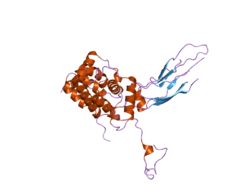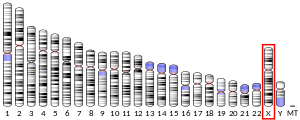OCRL
Inositol polyphosphate 5-phosphatase OCRL-1, also known as Lowe oculocerebrorenal syndrome protein, is an enzyme encoded by the OCRL gene located on the X chromosome in humans.[5]
This gene encodes a phosphatase enzyme involved in actin polymerization, and is found in the trans-Golgi network.[5]
Mutation in this gene are associated with oculocerebrorenal syndrome[6] and also with Dent's disease.[7][8]
References
- GRCh38: Ensembl release 89: ENSG00000122126 - Ensembl, May 2017
- GRCm38: Ensembl release 89: ENSMUSG00000001173 - Ensembl, May 2017
- "Human PubMed Reference:". National Center for Biotechnology Information, U.S. National Library of Medicine.
- "Mouse PubMed Reference:". National Center for Biotechnology Information, U.S. National Library of Medicine.
- "Entrez Gene: oculocerebrorenal syndrome of Lowe".
- Kawano T, Indo Y, Nakazato H, Shimadzu M, Matsuda I (June 1998). "Oculocerebrorenal syndrome of Lowe: three mutations in the OCRL1 gene derived from three patients with different phenotypes". Am. J. Med. Genet. 77 (5): 348–55. doi:10.1002/(SICI)1096-8628(19980605)77:5<348::AID-AJMG2>3.0.CO;2-J. PMID 9632163.
- Online Mendelian Inheritance in Man (OMIM): 300555
- Hoopes RR, Shrimpton AE, Knohl SJ, et al. (February 2005). "Dent Disease with mutations in OCRL1". Am. J. Hum. Genet. 76 (2): 260–7. doi:10.1086/427887. PMC 1196371. PMID 15627218.
Further reading
- Ross MT, Grafham DV, Coffey AJ, et al. (2005). "The DNA sequence of the human X chromosome". Nature. 434 (7031): 325–37. doi:10.1038/nature03440. PMC 2665286. PMID 15772651.
- Erdmann KS, Mao Y, McCrea HJ, et al. (2007). "A role of the Lowe syndrome protein OCRL in early steps of the endocytic pathway". Dev. Cell. 13 (3): 377–90. doi:10.1016/j.devcel.2007.08.004. PMC 2025683. PMID 17765681.
- Hyvola N, Diao A, McKenzie E, et al. (2006). "Membrane targeting and activation of the Lowe syndrome protein OCRL1 by rab GTPases". EMBO J. 25 (16): 3750–61. doi:10.1038/sj.emboj.7601274. PMC 1553191. PMID 16902405.
- Mao Y, Balkin DM, Zoncu R, et al. (2009). "A PH domain within OCRL bridges clathrin-mediated membrane trafficking to phosphoinositide metabolism". EMBO J. 28 (13): 1831–42. doi:10.1038/emboj.2009.155. PMC 2711190. PMID 19536138.
- Suchy SF, Cronin JC, Nussbaum RL (2009). "Abnormal bradykinin signalling in fibroblasts deficient in the PIP(2) 5-phosphatase, ocrl1". J. Inherit. Metab. Dis. 32 (2): 280–8. doi:10.1007/s10545-009-1058-3. PMID 19172411.
- Wu F, Reed AA, Williams SE, et al. (2009). "Mutational analysis of CLC-5, cofilin and CLC-4 in patients with Dent's disease". Nephron Physiol. 112 (4): 53–62. doi:10.1159/000225944. PMID 19546591.
- Coon BG, Mukherjee D, Hanna CB, et al. (2009). "Lowe syndrome patient fibroblasts display Ocrl1-specific cell migration defects that cannot be rescued by the homologous Inpp5b phosphatase". Hum. Mol. Genet. 18 (23): 4478–91. doi:10.1093/hmg/ddp407. PMID 19700499.
- Tosetto E, Addis M, Caridi G, et al. (2009). "Locus heterogeneity of Dent's disease: OCRL1 and TMEM27 genes in patients with no CLCN5 mutations". Pediatr. Nephrol. 24 (10): 1967–73. doi:10.1007/s00467-009-1228-4. PMID 19582483.
- Faucherre A, Desbois P, Nagano F, et al. (2005). "Lowe syndrome protein Ocrl1 is translocated to membrane ruffles upon Rac GTPase activation: a new perspective on Lowe syndrome pathophysiology". Hum. Mol. Genet. 14 (11): 1441–8. doi:10.1093/hmg/ddi153. PMID 15829501.
- Shrimpton AE, Hoopes RR, Knohl SJ, et al. (2009). "OCRL1 mutations in Dent 2 patients suggest a mechanism for phenotypic variability". Nephron Physiol. 112 (2): 27–36. doi:10.1159/000213506. PMID 19390221.
- Sekine T, Nozu K, Iyengar R, et al. (2007). "OCRL1 mutations in patients with Dent disease phenotype in Japan". Pediatr. Nephrol. 22 (7): 975–80. doi:10.1007/s00467-007-0454-x. PMID 17384968.
- Chabaâ L, Monnier N, Dahri S, et al. (2006). "[Oculo-cerebro-renal Lowe syndrome: clinical, biochemical and molecular studies in a Moroccan patient]". Ann. Biol. Clin. (Paris). 64 (1): 53–9. PMID 16420990.
- Choudhury R, Diao A, Zhang F, et al. (2005). "Lowe syndrome protein OCRL1 interacts with clathrin and regulates protein trafficking between endosomes and the trans-Golgi network". Mol. Biol. Cell. 16 (8): 3467–79. doi:10.1091/mbc.E05-02-0120. PMC 1182289. PMID 15917292.
- Sethi SK, Bagga A, Gulati A, et al. (2008). "Mutations in OCRL1 gene in Indian children with Lowe syndrome". Clin. Exp. Nephrol. 12 (5): 358–62. doi:10.1007/s10157-008-0059-0. PMID 18500547.
- Cui S, Guerriero CJ, Szalinski CM, et al. (2010). "OCRL1 function in renal epithelial membrane traffic". Am. J. Physiol. Renal Physiol. 298 (2): F335-45. doi:10.1152/ajprenal.00453.2009. PMC 2822509. PMID 19940034.
- McCrea HJ, Paradise S, Tomasini L, et al. (2008). "All known patient mutations in the ASH-RhoGAP domains of OCRL affect targeting and APPL1 binding". Biochem. Biophys. Res. Commun. 369 (2): 493–9. doi:10.1016/j.bbrc.2008.02.067. PMC 2442618. PMID 18307981.
- Hoopes RR, Shrimpton AE, Knohl SJ, et al. (2005). "Dent Disease with mutations in OCRL1". Am. J. Hum. Genet. 76 (2): 260–7. doi:10.1086/427887. PMC 1196371. PMID 15627218.
- Levtchenko EN, Monnens LA, Bökenkamp A, Knoers NV (2007). "[From gene to disease; Dent's disease caused by abnormalities in the CLCN5 and OCRL1 genes]". Ned Tijdschr Geneeskd. 151 (43): 2377–80. PMID 18019214.
- Choudhury R, Noakes CJ, McKenzie E, et al. (2009). "Differential clathrin binding and subcellular localization of OCRL1 splice isoforms". J. Biol. Chem. 284 (15): 9965–73. doi:10.1074/jbc.M807442200. PMC 2665120. PMID 19211563.
- Swan LE, Tomasini L, Pirruccello M, et al. (2010). "Two closely related endocytic proteins that share a common OCRL-binding motif with APPL1". Proc. Natl. Acad. Sci. U.S.A. 107 (8): 3511–6. doi:10.1073/pnas.0914658107. PMC 2840420. PMID 20133602.
External links
- GeneReviews/NCBI/NIH/UW entry on Lowe Syndrome
- OCRL+protein,+human at the US National Library of Medicine Medical Subject Headings (MeSH)
- PDBe-KB provides an overview of all the structure information available in the PDB for Human Inositol polyphosphate 5-phosphatase OCRL-1
This article is issued from Wikipedia. The text is licensed under Creative Commons - Attribution - Sharealike. Additional terms may apply for the media files.




